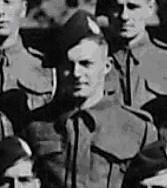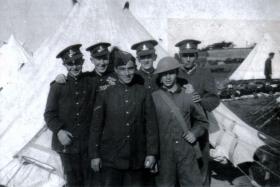Private. Charles Edward Naysmith. C-Company, 2nd Parachute Battalion.
Charles Naysmith was born on the 8 August 1921, and came from Kirkcaldy, Dunfermline, in Fife, Scotland.
He enlisted into the Royal Regiment of Artillery (TA) on the 3 February 1939, and undertook the normal week-ends training and that years annual camp, in July, with his unit, the 163rd (Fife) Heavy Battery, RA (TA), which was part of the Forth Heavy Regiment, RA (TA)
He was mobilised on the 1 September 1939, and on the 14 July 1940 his unit was redesignated the 505th Coastal Regiment, RA (TA)
He volunteered for Airborne Forces and was posted to the 2nd Parachute Battalion, which was based at Bulford, on the 13 June 1942.
Along with seventeen Other Ranks of the 2nd Parachute Battalion, and nearly one hundred others from the 1st Parachute Brigade, he was sent first to Hardwick Hall, for the selection and partial ground training phase and then onto RAF Ringway, on the 5 July 1942, to attend Parachute course No 17. He completed the course on the 13th July, having carried out two balloon descents and five Whitley aircraft descents to qualify as an Army Parachutist.
Back with the 2nd Battalion he was assigned to C-Company and sailed with them to North Africa in October 1942. This was as part of the Anglo-American Force taking part in Operation ‘Torch’. Based at Maison Blanche airfield near Algiers the battalion took off on a parachute operation on the 29th November, with their objectives being the enemy airfields of Depienne and Oudna in Tunisia. However, the attack by the ground forces to link up with them did not take place and the battalion ended up conducting a fighting withdrawal back to friendly lines over the next four to five days, and having suffered almost 50% casualties. Luckily Charles Naysmith was amongst those that that made it back.
The 2nd Battalion, along with the rest of the 1st Parachute Brigade, were now to be used as infantry to help hold the line that had been established in Tunisia, and there were many fierce actions against the German and Italian Forces. One of the fiercest was the Battle of Tamera at the end of March 1943, in which the amount of casualties being suffered in the 2nd and 3rd Parachute Battalion’s lead to a reorganisation, the following is taken from the War Diary:
28th March 1943.
2330 hrs. Order given out for continuation of second phase.
A composite Coy under the command of Major. Ross was formed from what remained of ‘A’, ‘B’ & ‘C’ Coys – This was known as No 1 Coy. ‘B’ Coy, 3rd Bn under major. Dobie became No 2 Coy, while ‘A’ Coy, 3rd Bn became No 3 Coy.
29th March 1943.
0330 hrs. No 1 Coy left area (j076706) to clear any enemy from point 247 and then swinging round to occupy the high ground overlooking the viaduct (J096716).
0415 hrs. No 2 Coy left are to reinforce 1 Coy should it be necessary. No 1 Coy occupy .247 without opposition, capturing eleven prisoners.
0630 hrs. Adv BHQ consisting of the C.O, Intelligence & Protective Section, left area. 3 German stragglers were collected in the woods and another wounded.
No 1 Coy occupy their objective taking a further two prisoners.
0830 hrs. Bn in position on high ground overlooking viaduct.
0900 hrs. A patrol from 1 Coy under Capt. Brayley set out to move up the S.W. slopes of Sidi Mohamed Belkassem & find out whether it was held by the enemy.
10.30 hrs. Patrol reported Bn’s final objective clear of enemy having taken three prisoners. Bn commenced moving forward crossing the river at (J095716) & doing this last bound on to its old positions by road. Five Italian P.W’s were taken over from our friends the Goumes en-route.
11.45 hrs. Bn on its final objective. Coys took up dispositions at follows: No 3 Coy (J100723). 1 Coy (J103718). 2 Coy (J105721). A further three German P.W’s were taken over from the 1st bn.
During the course of the battle the Bn took in all 58 German prisoners in addition to those handed over to us by other Bn’s. No count of casualties inflicted was possible, but these must have been considerable. The Bn’s casualties were fortunately not so heavy as at first believed.
Amounting to 2 Officers & 14 O.R’s killed, 3 Officers & 60 x O.R’s wounded. 2 O.R’s missing.
During the action the Bn came into contact with elements of four different German units.
The C/A [Counter-Attack] delivered against our positions on the morning of the 28th was made by Parachute Engineer troops reinforced with ordinary infantry. The C/A which was carried out with extreme determination was later reported to have been led by Major. Witzig in person.
Unfortunately one of those that was badly wounded was Charles Naysmith, who had to be evacuated back to an Aid Post, and from there back to a Field Hospital for treatment. He was sent back to the United Kingdom, arriving there on the 20 May 1943.
His wounds were severe enough that he was discharged from further military service on the 16 December 1943.
He was officially awarded the following medals;
1939-45 Star.
Africa Star (1st Army Clasp).
War Medal 1939/45.
Defence Medal.
Kindly submitted by R Hilton
Read More




Latest Comments
Add Comment
In order to add comments you must be registered with ParaData.
If you are currently a ParaData member please login.
If you are not currently a ParaData member but wish to get involved please register.